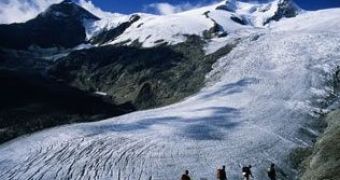Glaciers appear only on high mountains and around the Poles. Through their movements, the ice blocks shape distinct relief forms, like U-shaped valleys, while the eroded matter is deposed as moraines. At the edge of glacial regions, there can be found periglacial areas. Temperatures are still low, but with a slightly higher average annual value. A relief form that is typical for these areas is represented by the dome-shaped hills called pingos, formed when water freezes below the soil surface and pushes up the upper layers of soil or gravels.
In the glacial regions, the rock erosion is made mechanically (physical degradation) or through the action of the cold causing the constant freeze and melting. Chemical erosion, like that induced by water, carbon dioxide and organic acids, is minor here as the cold slows down the chemical reactions.
Normally, the broken fragments of rocks have sharp edges. Such fragments agglomerate in piles of gravel or taluses, when the freeze action occurred on steep slopes. Sometimes, avalanches train thousands of tonnes of snow and eroded rocks along steep slopes. In 1991, a massive avalanche in the Cook Mountains (New Zealand's tallest) shortened the mountain with a few meters by the collapse of its peak and cut a side in the mountain of about 5 km (3 mi).
Smoother slopes slow the down movement of the matter, but they can be affected by sudden land slips and mud flood.
The arid or semiarid areas can form flat plateaus, like in many parts of Australia and Africa, or fragmented plateaus like in southwestern US. The relief is shaped here by strong winds, lack of vegetation, and the water torrents. The rocks crack due to their heating and sudden cooling. The heated rocks interact with the dew or rare rain droplets. Characteristic for these areas are the hills with abrupt edges, called high plateaus or high terraces.
Chemical erosion is intense in wet and warm tropics. Rounded slopes and hills are the result of the balance between the products of erosion and torrential rainfall.

 14 DAY TRIAL //
14 DAY TRIAL //